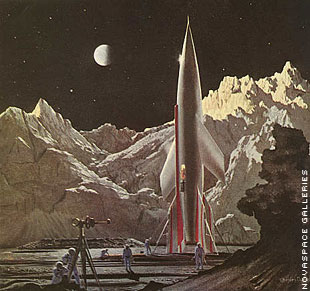
Back on Earth, Bedford receives an explanatory radio transmission from Cavor (that was Wells's idea, actually), telling him how he has inadvertently set in train a plan by the Selenites to attack Earth. It's worth staying on, though, to see how cleverly Gatiss ties everything up. What remains is essentially a long epilogue. Once the double act of Bedford and Cavor is broken up forever – the former escapes, the latter is marooned – the narrative runs out of steam. Alien encounters are handled with more verve in Doctor Who. It looks as if Gatiss decided to give his creatures a retro, Harryhausen-style flicker, and it's the one false note. The ant-like Selenites, intelligent but fragile (literally – you punch them and their heads explode) beings that populate the moon's core, are a little unconvincing, and the plight of the captured space travellers correspondingly unengrossing.

Up on the moon (sorry, in the moon), however, the drama hits a soggy spot. On finally reaching the moon, with Bedford filming the flag-planting for posterity, the professor launches into a Pooterish approximation of Neil Armstrong's famous words: "What is this for us, but a tiny footfall. "Cabin lights should be dimmed for take-off, don't you think?" says Cavor just before they embark. There was some fun to be had drawing sly parallels between the antique and the modern. As with the later dream sequence recalling Georges Méliès's silent film Voyage Dans la Lune, it was a strange kind of inverse homage: Wells provided the original inspiration in both cases. The scenes focusing on the preparation for the voyage were a bit like a live action version of Wallace and Gromit's A Grand Day Out – the ship's interior is just as cosily appointed. In exploring the idea of putting a man on the moon more than a century ago, the story reminds us how crazy the idea still seems: 40 years after it actually happened, there are still people who don't believe it. Gatiss and Kinnear have great fun fleshing out two rather bloodless characters, with Kinnear exploring the hidden shallows of the incurious, unscrupulous Bedford, and Gatiss imbuing the professor with several alarming tics. When Cavor lectured Bedford on how their cavorite-coated spaceship might be piloted using roller blinds, I felt I understood perfectly. The science that makes Edwardian space travel possible (it's all down to "cavorite", a substance of the professor's invention that blocks the effects of gravity) may be preposterous, but it's still carefully explained. Making a virtue of the story's anachronisms, he plays the whole thing more or less in earnest. What follows is remarkably faithful to the Wells novel, which Gatiss treats playfully, but without sticking his tongue in his cheek. You immediately find yourself thinking: what if the Edwardians had been to the moon?

Thanks to this neat framing device, what was once obsolete sci-fi is now alternative history. The old film spooling through his projector takes us back another 70 years, when he, a young, feckless entrepreneur called Julius Bedford ( Rory Kinnear) first meets the eccentric Professor Cavor, played by Gatiss. A creepy old man who runs a "kinematographic" tent show tells a young boy that actually, he had been the first man on the moon. It begins in 1969, on the eve of the Apollo moon landings, at an English funfair. His solution – a rather brilliant one – is to backdate the story, but only by 40 years.

Hg wells first man on the moon update#
W ith his adaptation of HG Wells's The First Men In The Moon (BBC4), Mark Gatiss set himself a puzzle: how could he convey the obvious admiration he feels for Wells as a visionary while dramatising a tale that is in many ways fantastically quaint? You can't update a story about Edwardians going to the moon.


 0 kommentar(er)
0 kommentar(er)
